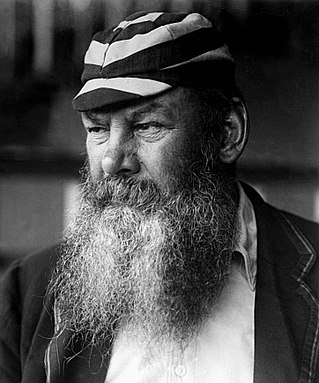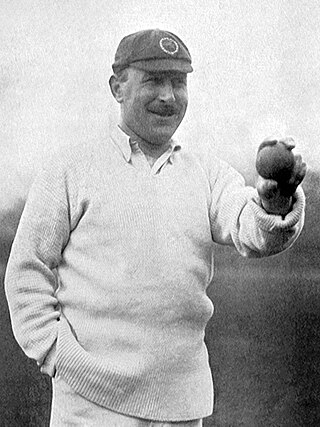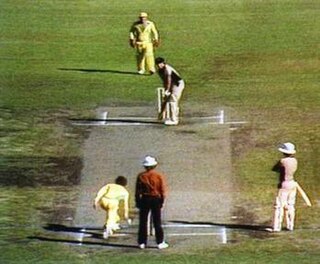Related Research Articles

William Gilbert Grace was an English amateur cricketer who was important in the development of the sport and is widely considered one of its greatest players. He was nominally amateur as a cricketer, but he is said to have made more money from his cricketing activities than any professional cricketer. He was an extremely competitive player and, although he was one of the most famous men in England, he was also one of the most controversial on account of his gamesmanship and moneymaking.

Bowling, in cricket, is the action of propelling the ball toward the wicket defended by a batter. A player skilled at bowling is called a bowler; a bowler who is also a competent batter is known as an all-rounder. Bowling the ball is distinguished from throwing the ball by a strictly specified biomechanical definition, which restricts the angle of extension of the elbow. A single act of bowling the ball towards the batsman is called a ball or a delivery. Bowlers bowl deliveries in sets of six, called an over. Once a bowler has bowled an over, a teammate will bowl an over from the other end of the pitch. The Laws of Cricket govern how a ball must be bowled. If a ball is bowled illegally, an umpire will rule it a no-ball. If a ball is bowled too wide of the striker for the batsman to be able to play at it with a proper cricket shot, the bowler's end umpire will rule it a wide.
Underarm bowling is a style of bowling in cricket. The style is as old as the sport itself. Until the introduction of the roundarm style in the first half of the 19th century, bowling was performed in the same way as in the sport of bowls, with the ball being delivered with the hand below the waist. Bowls may well be an older game than cricket and it is possible that it provided a template for delivering a ball with a degree of accuracy.

George Herbert Hirst was a professional English cricketer who played first-class cricket for Yorkshire County Cricket Club between 1891 and 1921, with a further appearance in 1929. One of the best all-rounders of his time, Hirst was a left arm medium-fast bowler and right-handed batsman. He played in 24 Test matches for England between 1897 and 1909, touring Australia twice. He completed the double of 1,000 runs and 100 wickets in an English cricket season 14 times, the second most of any cricketer after his contemporary and team-mate Wilfred Rhodes. One of the Wisden Cricketers of the Year for 1901, Hirst scored 36,356 runs and took 2,742 wickets in first-class cricket. In Tests, he made 790 runs and captured 59 wickets.
Gentlemen v Players was a long-running series of cricket matches that began in July 1806 and was abolished in January 1963. It was a match between a team consisting of amateurs and a team consisting of professionals that reflected the English class structure of the 19th century. Typically, the professionals were working class people who earned their living by playing cricket, while the amateurs were middle- and upper-class products of the public school system, who were supposedly unpaid for playing. The professionals were paid wages by their county clubs and/or fees by match organisers, while the amateurs claimed expenses. However, while rules to distinguish amateurs from professionals were established by Marylebone Cricket Club (MCC), the system of allowable expenses was both controversial and complex, enabling some leading amateurs to be paid more than any professional for playing cricket.

William "Silver Billy" Beldham was an English professional cricketer who played for numerous teams between 1782 and 1821. He was born at Wrecclesham, near Farnham in Surrey, and died at Tilford, Surrey. In some sources, his name has been given as "Beldam" or "Beldum". A right-handed batting all-rounder, he is widely recognised as one of the greatest batsmen of cricket's underarm era. Using an underarm action, he bowled pitched deliveries at a fast medium pace. He generally fielded in close catching positions, mostly at slip and sometimes played as wicket-keeper.
In cricket, roundarm bowling is a bowling style that was introduced in the first quarter of the 19th century and largely superseded underarm bowling by the 1830s. Using a roundarm action, the bowlers extend their arm about 90 degrees from their body at the point where they release the ball. Roundarm fell into decline after 1864 when the current style of overarm bowling was legalised, although W. G. Grace continued to use it to the end of his career.

The Reverend Lord Frederick de Vere Beauclerk, a 19th-century Anglican priest, was an outstanding but controversial English first-class cricketer, the leading "amateur" player of the Napoleonic period.

William Lambert was an English professional cricketer who played for numerous teams between 1801 and 1817. He was born at Burstow in Surrey, and died at Nutfield, Surrey. A right-handed batting all-rounder, he is widely recognised as one of the greatest batters of cricket's underarm era. Using an underarm action, he bowled pitched deliveries at a slow pace. He generally fielded in close catching positions, mostly at slip and often played as wicket-keeper.

The underarm bowling incident of 1981 is a sporting controversy that took place on 1 February 1981, when Australia played New Zealand in a One Day International cricket match, the third in the best-of-five final of the 1980–81 World Series Cup, at the Melbourne Cricket Ground.

William Richard Hillyer, was a prominent 19th century English professional cricketer for Kent County Cricket Club, Marylebone Cricket Club (MCC) and many other sides in the days before county and international cricket was organised into regular competitions. He was born at Leybourne in Kent in 1813, the son of an innkeeper.
James "Jem" Broadbridge (1795–1843) was an English professional cricketer who is widely considered the outstanding all-rounder in England during the 1820s. He played mainly for Sussex teams and made 102 known appearances in first-class cricket from 1814 to 1840, being best remembered for his part in the introduction of roundarm bowling. He played for the Players in the Gentlemen v Players series and the South in the North v. South series.
Thomas Charles Howard was an English professional cricketer who played first-class cricket from 1803 to 1828. He was mainly associated with Hampshire sides but also played for Marylebone Cricket Club (MCC), where he was employed as a ground staff bowler.
William Ashby was an English cricketer who played mainly for Kent teams. He was considered one of the best slow bowlers of his era and one of the pioneers of roundarm bowling.
John Hammond was an English cricketer of the late 18th and early 19th century. He was one of the greatest early Sussex players.
John Bennett was an English professional cricketer who made 61 known appearances in first-class cricket matches between 1797 and 1818. His cousin was James Bennett who played in five matches from 1798 to 1805. Not to be confused with John Bennett
Herbert Jenner was an English barrister. As an amateur cricketer he played first-class cricket from 1825 to 1838. He changed his name to Herbert Jenner-Fust in 1864.
William Mortlock was an English professional cricketer who played first-class cricket from 1851 to 1870. His brother Thomas was a first-class umpire.
George Brown was an English professional cricketer who played first-class cricket from 1819 to 1838.
Through the Napoleonic Wars, county cricket virtually died as cricket was impacted by losses of investment and manpower.
References
- 1 2 "William Fennex". Cricinfo. Retrieved 7 June 2020.
- ↑ "William Fennex". CricketArchive. Retrieved 7 June 2020.
- 1 2 3 E. V. Lucas, Cricket All His Life, Rupert Hart-Davis, London, 1950, p. 22–23.
- ↑ CricketArchive – scorecard of inaugural Gentlemen v Players match